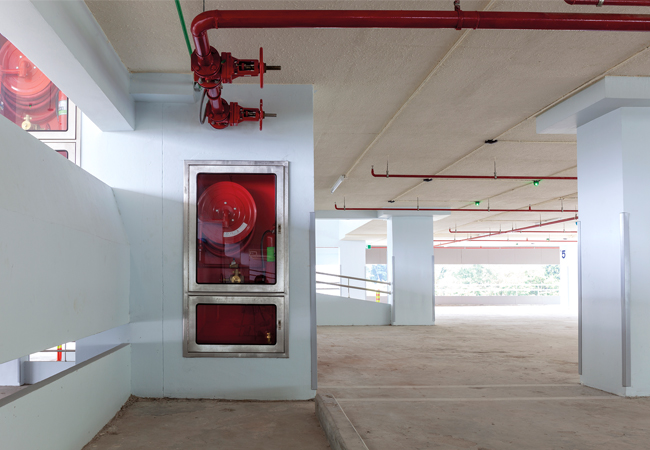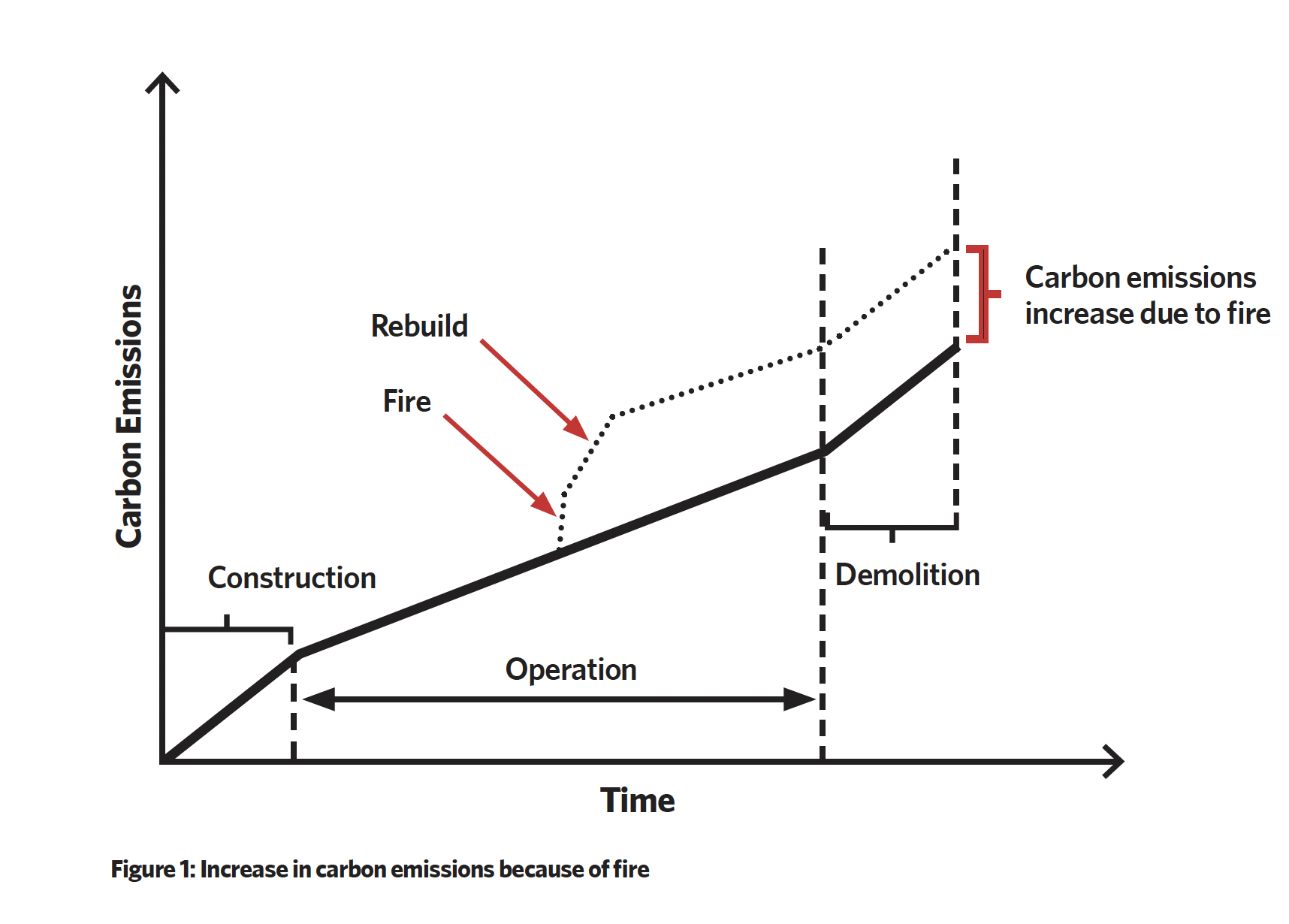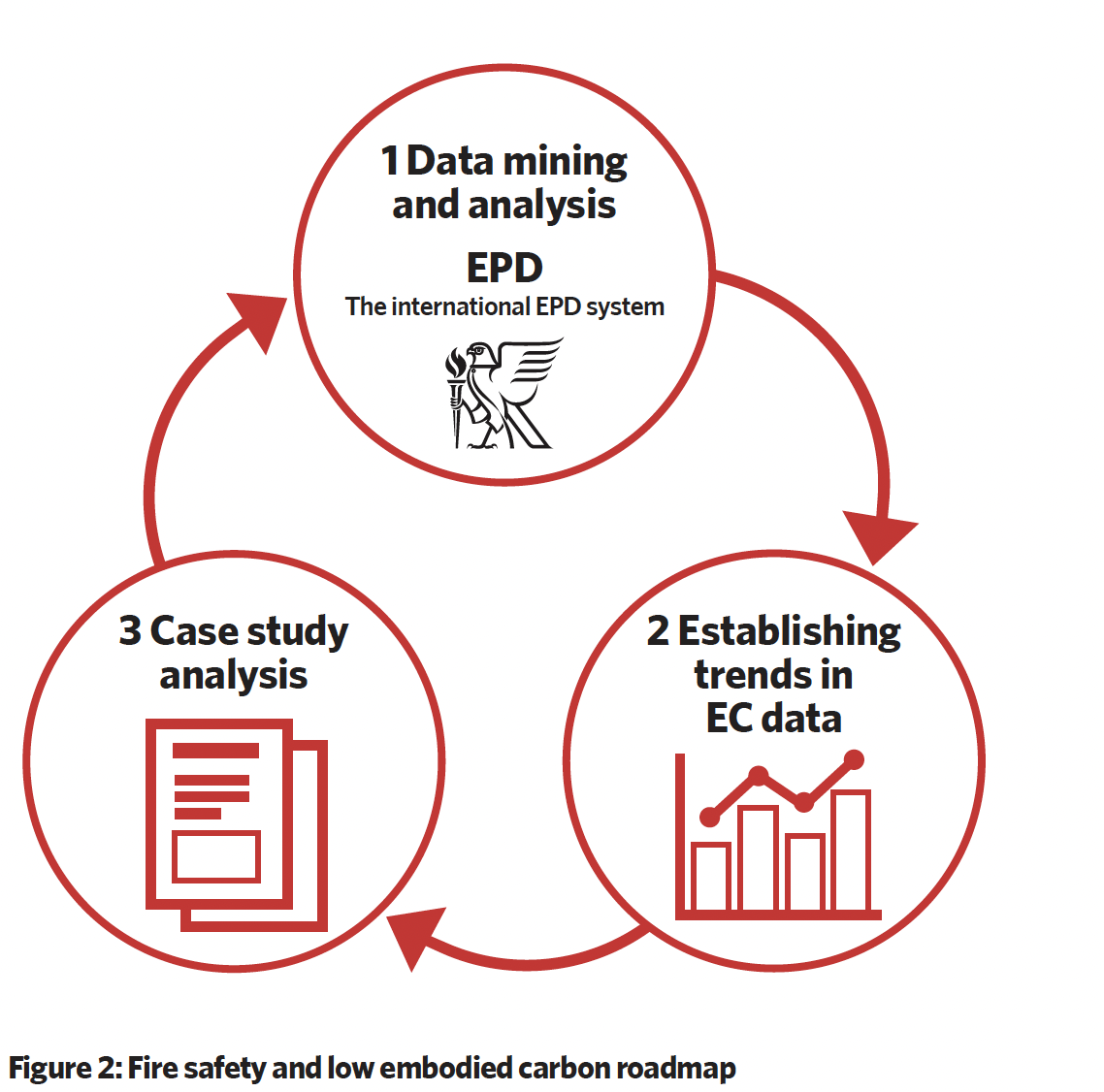
Fire remains a significant safety concern in the built environment, alongside the pressing need to decarbonise. As we strive to engineer buildings with low embodied carbon, it is crucial to ensure that novel designs and technologies do not compromise fire safety.
Research presented by Grete Wilson and Dr Emma McIntyre at the 2024 CIBSE Technical Symposium highlighted the evolving focus for fire safety engineers, setting out a roadmap to achieving safe, low carbon designs.
Traditionally, embodied carbon has not been a focus for fire safety engineers. At their core, however, is the aim to minimise the carbon impact of buildings by reducing the likelihood and consequence of a fire occurring in the first instance. An FM Global study summarised1 that carbon emissions increase by 30-40kgCO2e.m-2 of floor area when effective fire safety measures, such as automatic fire suppression, are not provided, exacerbating the impact of a fire (see Figure 1).

Fire safety engineers can consider the impact they have on embodied carbon through the fire safety measures they propose. For example, some building elements that exist might inherently meet fire safety requirements and do not need modifying for fire safety reasons – for example, walls and floors. Others may require modification to comply with the safety requirements – for example, changing the material in the external wall. Further, there are building elements that exist solely for fire safety reasons including fire suppression, fire detection and alarm systems.
As a priority, the amount of embodied carbon associated with building elements that exist just for fire safety purposes should be measured and understood. This understanding will help in making informed decisions that balance fire safety and carbon-reduction goals.
When establishing how a building responds in a fire, fire safety engineers typically set performance requirements for the specification, and guide clients and design teams to achieve regulatory compliance for the end products selected.
This should be included from RIBA Stage 2 (Concept Design), or earlier, when strategy-level options are presented and considered holistically with the design team. The primary goal of the fire safety engineers at this stage is to present options that could satisfy statutory requirements, along with any additional fire safety goals set out by the client.
The regulatory framework in the UK allows fire safety engineers to consider multiple fire strategy options to demonstrate compliance. In some scenarios, for example, providing an automatic sprinkler installation allows a reduction in fire-resistance periods of load-bearing structures. It is unknown, however, which option worsens the impact on embodied carbon: the combination of sprinklers and reduced structural fire protection or comparatively more structural fire protection.
It is recognised that the greatest influence on the final design is at earlier design stages, so – if embodied carbon impact was known – an appraisal of fire strategy options could be undertaken that demonstrated the most desirable balance between low embodied carbon design and fire safety.
The roadmap
To enable low embodied carbon design, fire safety engineers, in collaboration with sustainability consultants and other engineers, should carry out the following three steps (see Figure 2):

Step 1: Data mining and analysis
We need to harness and harmonise global embodied carbon information for the fire safety measures proposed in buildings. Fire safety engineers have not traditionally been involved in product-level specification.
Typically, it might be expected that this would be provided in the form of Environmental Product Declarations (EPDs) or carrying out estimations based on a CIBSE TM65 calculation. We acknowledge that there are limitations in embodied carbon data in these forms – for example, limited production of EPDs, inconsistency between EPD reporting, and conservatism in CIBSE TM65 calculations.
Step 2: Establishing trends in embodied carbon data
After successful mining of embodied carbon data for fire safety measures, the next step is to understand the variation in the data on a product and/or system basis. Through engagement with sustainability consultants, it is necessary to determine where data can be plotted against a common variable – for example, period of fire resistance – to establish trends in the embodied carbon for a fire safety measure such as compartmentation. It may then be possible to use these trends to estimate the embodied carbon impact at concept stage. Crucially, it should be recognised that this data is based on a dataset at a given time.
Step 3: Case-study analysis
Establishing embodied carbon trends provides the opportunity to undertake optioneering at concept stage, considering both fire safety and low embodied carbon design.
As described above, fire safety engineers often specify certain fire safety measures that permit ‘relaxations’ in other aspects of the design. To determine the embodied carbon impact of fire safety relaxations, a case-study analysis can be undertaken on an existing building project to consider the relative change in embodied carbon when sprinklers are provided vs non-sprinklered fire-resistance requirements for the structure of a single floor.
Following the initial test case, this can be expanded to a full building and to different types of buildings that incorporate alternate construction techniques (for example, mass timber) and other fire safety systems (for example, smoke extract).
Undertaking case studies of common ‘fire safety relaxations’ to study the aggregated embodied carbon impact, and making those findings widely available will enable fire safety engineers to knowingly influence the design at concept stage.
Gradually, the outcomes of the various case-study analyses can inform decisions made at concept stage to fire safety engineers, to better engage with design teams on fire safety and embodied carbon project goals.
Ultimately, it is necessary to holistically assess the impact of fire safety strategies and work collaboratively to design low embodied carbon buildings, safely.
- The paper was presented at the 2024 CIBSE Technical Symposium www.cibse.org/symposium
The 2025 symposium is from 24-25 April 2025, in London.
About the authors
Grete Wilson AIFIRE, is fire safety engineer, and DR Emma McIntyre AIFIRE, is senior fire safety engineer at Arup’s Edinburgh office
References:
- Gritzo L A, Doerr W, Bill R, Ali H, Nong S and Krasner L, ‘The influence of risk factors on sustainable development’, FM Global Research Division Technical Report. 2009.
